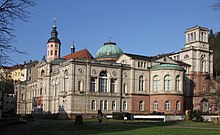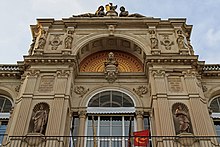Friedrichsbad
The Friedrichsbad is a Roman-Irish thermal bath in the Baden-Württemberg city of Baden-Baden .
requirements
In 1868, Grand Duke Friedrich I commissioned the Baden-Baden district building inspector Karl Dernfeld, together with the Grand Ducal spa doctor Carl Frech , to visit well-known city and spa establishments in order to implement the knowledge gained during the construction of the Friedrichsbad. In view of the imminent casino ban in the years before the founding of the empire in 1871 and which came into force in 1872, the modernization of the baths was important for Baden-Baden in order to remain attractive for guests and to attract new guests.
Direct models for the Friedrichsbad are the Raitzenbad in Budapest and the Graf-Eberhardsbad (today Palais Thermal ) in Bad Wildbad ( district of Calw ). From an earlier study trip to Italy, the district architect was also familiar with the ancient thermal baths, the archaeological exploration of which became more and more the focus of interest in the 19th century. There were also other influences from Great Britain. The introduction of the Roman or Turkish bath in Europe is thanks to the British diplomat David Urquhart (1805–1877), who was familiar with oriental bathing customs through his stays abroad . After the Crimean War (1853-1856), the Irish doctor Richard Barther (1802-1870), influenced by the ideas of Urquhart, founded the first Turkish bath in Western Europe in 1856 in St. Anne's Hill near Cork in Ireland.
Building history
The Friedrichsbad was the most important German thermal bath in the second half of the 19th century and at that time it was considered the most beautiful thermal bathhouse in Europe. It was built between 1869 and 1877 after an old town quarter was demolished on the historic site of the Florentine Hill, on which the Romans had already built their thermal baths. The long construction period was caused by the Franco-German War , the discovery of Roman bath ruins underground, financing problems and the difficult building site on the slope of the Florentinerberg. The plans by the architect Dernfeld are lost. Compared to the residential buildings in the immediate vicinity, the building made of red and white sandstone (the inner walls are made of brick) with the dimensions 62.5 × 50 meters has enormous dimensions. The Friedrichsbad adapts to the steep slope due to its division into three uphill structures. Dernfeld built it in the neo-renaissance style .
The layout of the Friedrichsbad is strictly axially symmetrical. It is based on the ancient models of Baths of Caracalla and Baths of Diocletian in Rome. A domed structure with a circular exercise pool is at the center of the complex both ideally and geometrically. Based on the model of the caldarium of the Baths of Caracalla, the room, divided by eight blind arches on Corinthian columns, has a 17.5 meter high dome.
Based on the palaces of the Italian High Renaissance , the main facade of the Friedrichsbad on Römerplatz has a simple basement and an elaborate upper floor. It is structured by a triumphal arch-like, three-storey central risalit and corner risalit. In the arches of the upper floor of the richly structured facade there are portrait medallions and two figure niches, which provide space for an extensive iconographic program, which is supplemented by inscriptions. They show more or less arbitrarily selected rulers and scholars who were important for the development of the spa industry in general or for the history of the city.
In 1950, the original painting of the Friedrichsbad was whitewashed in accordance with the purist taste of the mid-20th century. The wall paintings in Baden-Baden were not completely destroyed, but only a small part was restored during the extensive restoration of the building in 1980/81.
See also
literature
- Karlfriedrich Ohr: The Friedrichsbad in Baden-Baden. A monument to 19th century bathing culture. In: Denkmalpflege in Baden-Württemberg , 25th year 1996, issue 1, pp. 79–88. ( online as PDF )
- Ulrich Coenen: Bathing in Baden-Baden. From the Roman facilities to the modern Caracallatherme. In: Die Ortenau, publications of the historical association for Mittelbaden , 81 (2001), pages 189–228.
- Ulrich Coenen: From Aquae to Baden-Baden. The building history of the city and its contribution to the development of the spa architecture . Publishing house Mainz, Aachen 2008.
Individual evidence
- ^ JO Engert, R. Haehling von Lanzenauer, H. Leis: City guide Baden-Baden. Published by the working group for urban history of the city of Baden-Baden eV Volume 7, 2005, ISSN 0936-742X .
Web links
Coordinates: 48 ° 45 ′ 47.2 " N , 8 ° 14 ′ 31.9" E


